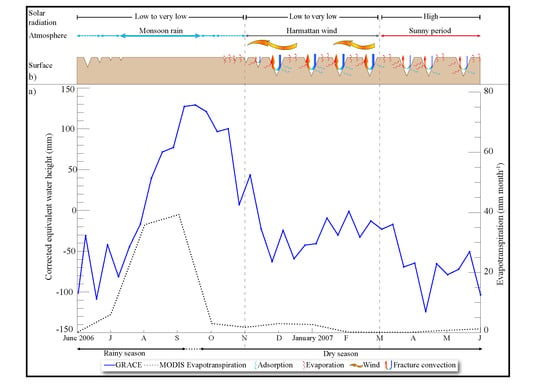Investigation of Short-Term Evolution of Soil Characteristics over the Lake Chad Basin Using GRACE Data
Abstract
1. Introduction
2. Description of the Lake Chad Basin
2.1. Climate and Hydrology
2.2. Geology of the Basin
3. Data and Methods
3.1. GRACE Data
3.2. Rainfall and Evapotranspiration Data
3.3. Method
4. Temporal Evolution of the Water Mass
5. Lake Chad Elevation, Rainfall, and Evapotranspiration Rate
5.1. Lake Chad Evolution
5.2. Rainfall Data
5.3. Evapotranspiration Data
6. Discussion
6.1. Influence of Surface Water
6.2. Influence of Evapotranspiration
6.3. Influence of the Surface Permeability of Clays
7. Conclusions
Author Contributions
Funding
Acknowledgments
Conflicts of Interest
References
- Grodsky, S.A.; Carton, J.A. Coupled land/atmosphere interactions in the West African Monsoon. Geophys. Res. Lett. 2001, 28, 1503–1506. [Google Scholar] [CrossRef]
- Sultan, B.; Janicot, S. Abrupt shift of the ITCZ over West Africa and intra-seasonal variability. Geophys. Res. Lett. 2000, 27, 3353–3356. [Google Scholar] [CrossRef]
- Sultan, B.; Janicot, S. The West African Monsoon Dynamics. Part II: The “Preonset” and “Onset” of the Summer Monsoon. J. Clim. 2003, 16, 3407–3427. [Google Scholar] [CrossRef]
- Louvet, S.; Janicot, S. Study of the first guinean rainy season and role of the subtropical jet of the northern hemisphere. In Proceedings of the EGS-AGU-EUG Joint Assembly, Nice, France, 6–11 April 2003; p. 9321. [Google Scholar]
- Sultan, B.; Janicot, S.; Diedhiou, A. The West African Monsoon Dynamics. Part I: Documentation of Intraseasonal Variability. J. Clim. 2003, 16, 3389–3406. [Google Scholar] [CrossRef]
- Matthews, A.J. Intraseasonal Variability over Tropical Africa during Northern Summer. J. Clim. 2004, 17, 2427–2440. [Google Scholar] [CrossRef]
- Fontaine, B.; Louvet, S.; Roucou, P. Fluctuations in annual cycles and inter-seasonal memory in West Africa: Rainfall, soil moisture and heat fluxes. Theor. Appl. Climatol. 2007, 88, 57–70. [Google Scholar] [CrossRef]
- Koster, R.D.; Dirmeyer, P.A.; Guo, Z.; Bonan, G.; Chan, E.; Cox, P.; Gordon, C.T.; Kanae, S.; Kowalczyk, E.; Lawrence, D.; et al. Regions of Strong Coupling Between Soil Moisture and Precipitation. Science 2004, 305, 1138–1140. [Google Scholar] [CrossRef] [PubMed]
- Leblanc, M.; Razack, M.; Dagorne, D.; Mofor, L.; Jones, C. Application of METEOSAT thermal data to map soil infiltrability in the central part of the Lake Chad basin, Africa. Geophys. Res. Lett. 2003, 30. [Google Scholar] [CrossRef]
- Schneider, J.L.; Wolff, J.P. Carte Géologique et Hydrogéologique à 1/1,500,000 de la république du Tchad. Mémoire explicatif; BRGM: Orleans, France, 1992; Volume 2, p. 571. [Google Scholar]
- Aranyossy, J.F.; Ndiaye, B. Étude et modélisation de la formation des dépressions piézométriques en Afrique sahelienne. J. Water Sci. 1993, 6, 81–96. [Google Scholar] [CrossRef]
- Lopez, T.; Antoine, R.; Kerr, Y.; Darrozes, J.; Rabinowicz, M.; Ramillien, G.; Cazenave, A.; Genthon, P. Subsurface Hydrology of the Lake Chad Basin from Convection Modelling and Observations. Surv. Geophys. 2016, 37, 471–502. [Google Scholar] [CrossRef]
- Save, H.; Bettadpur, S.; Tapley, B.D. High-resolution CSR GRACE RL05 mascons. J. Geophys. Res. Solid Earth 2016, 121, 7547–7569. [Google Scholar] [CrossRef]
- Tapley, B.D.; Bettadpur, S.; Ries, J.C.; Thompson, P.F.; Watkins, M.M. GRACE Measurements of Mass Variability in the Earth System. Science 2004, 305, 503–505. [Google Scholar] [CrossRef] [PubMed]
- Grippa, M.; Kergoat, L.; Frappart, F.; Araud, Q.; Boone, A.; de Rosnay, P.; Lemoine, J.-M.; Gascoin, S.; Balsamo, G.; Ottlé, C.; et al. Land water storage variability over West Africa estimated by Gravity Recovery and Climate Experiment (GRACE) and land surface models. Water Resour. Res. 2011, 47, W05549. [Google Scholar] [CrossRef]
- Nahmani, S.; Bock, O.; Bouin, M.-N.; Santamaŕıa-Gómez, A.; Boy, J.-P.; Collilieux, X.; Métivier, L.; Panet, I.; Genthon, P.; de Linage, C.; et al. Hydrological deformation induced by the West African Monsoon: Comparison of GPS, GRACE and loading models. J. Geophys. Res. Solid Earth 2012, 117. [Google Scholar] [CrossRef]
- Swenson, S.; Famiglietti, J.; Basara, J.; Wahr, J. Estimating profile soil moisture and groundwater variations using GRACE and Oklahoma Mesonet soil moisture data. Water Resour. Res. 2008, 44, W01413. [Google Scholar] [CrossRef]
- Pfeffer, J.; Champollion, C.; Favreau, G.; Cappelaere, B.; Hinderer, J.; Boucher, M.; Nazoumou, Y.; Oï, M.; Mouyen, M.; Henri, C.; et al. Evaluating surface and subsurface water storage variations at small time and space scales from relative gravity measurements in semiarid Niger. Water Resour. Res. 2013, 49, 3276–3291. [Google Scholar] [CrossRef]
- Ramillien, G.; Frappart, F.; Seoane, L. Application of the regional water mass variations from GRACE satellite gravimetry to large-scale water management in Africa. Remote Sens. 2014, 6, 7379–7405. [Google Scholar] [CrossRef]
- Bader, J.-C.; Lemoalle, J.; Leblanc, M. Modèle hydrologique du Lac Tchad. Hydrol. Sci. J. 2011, 56, 411–425. [Google Scholar] [CrossRef]
- Descloitres, M.; Chalikakis, K.; Legchenko, A.; Moussa, A.M.; Genthon, P.; Favreau, G.; Coz, M.L.; Boucher, M.; Oï, M. Investigation of groundwater resources in the Komadugu Yobe Valley (Lake Chad Basin, Niger) using MRS and TDEM methods. J. Afr. Earth Sci. 2013, 87, 71–85. [Google Scholar] [CrossRef]
- Adedokun, J.A.; Emofurieta, W.O.; Adedeji, O.A. Physical, mineralogical and chemical properties of harmattan dust at Ile-Ife, Nigeria. Theor. Appl. Clim. 1989, 40, 161–169. [Google Scholar] [CrossRef]
- Schuster, M.; Roquin, C.; Duringer, P.; Brunet, M.; Caugy, M.; Fontugne, M.; Mackaye, H.T.; Vignaud, P.; Ghienne, J.-F. Holocene Lake Mega-Chad palaeoshorelines from space. Quat. Sci. Rev. 2005, 24, 1821–1827. [Google Scholar] [CrossRef]
- Leblanc, M.; Favreau, G.; Maley, J.; Nazoumou, Y.; Leduc, C.; Stagnitti, F.; van Oevelen, P.J.; Delclaux, F.; Lemoalle, J. Reconstruction of Megalake Chad using Shuttle Radar Topographic Mission data. Palaeogeogr. Palaeoclim. Palaeoecol. 2006, 239, 16–27. [Google Scholar] [CrossRef]
- Crétaux, J.-F.; Birkett, C. Lake studies from satellite radar altimetry. C. R. Geosci. 2006, 338, 1098–1112. [Google Scholar] [CrossRef]
- Coe, M.T.; Birkett, C.M. Calculation of river discharge and prediction of lake height from satellite radar altimetry: Example for the Lake Chad basin. Water Resour. Res. 2004, 40, W10205. [Google Scholar] [CrossRef]
- Seeber, K. 2nd Misson on Discharge Measurements at Chari, Logone and Koulambou River, Chad; Lake Chad Basin Commission, 2013; Available online: http://www.cblt.org/sites/default/files/download_documents/bgr_report_6_engl.pdf (accessed on 4 June 2018).
- Leduc, C.; Salifou, O.; Leblanc, M. Evolution des ressources en eau dans le département de Diffa (bassin du lac Tchad, sud-est nigérien). In Water Resources Variability in Africa during the XXth Century; IAHS Publications: Oxfordshire, UK, 1998; Volume 252. [Google Scholar]
- Genik, G.J. Regional framework, structural and petroleum aspects of rift basins in Niger, Chad and the Central African Republic (C.A.R.). Tectonophysics 1992, 213, 169–185. [Google Scholar] [CrossRef]
- Olugbemiro, O.R.; Ligouis, B. Thermal maturity and hydrocarbon potential of the Cretaceous (Cenomanian-Santonian) sediments in the Bornu (Chad) basin, NE Nigeria. Bull. Soc. Geol. Fr. 1999, 170, 759–772. [Google Scholar]
- Griffin, D.L. The late Neogene Sahabi rivers of the Sahara and their climatic and environmental implications for the Chad Basin. J. Geol. Soc. 2006, 163, 905–921. [Google Scholar] [CrossRef]
- Servant, M. Données stratigraphiques sur le Quaternaire supérieur et récent au nord-est du Lac Tchad. Cah. ORSTOM 1970, 2, 95–114. [Google Scholar]
- Edmunds, W.M.; Fellman, E.; Goni, I.B. Lakes, groundwater and palaeohydrology in the Sahel of NE Nigeria: Evidence from hydrogeochemistry. J. Geol. Soc. 1999, 156, 345–355. [Google Scholar] [CrossRef]
- Schuster, M.; Duringer, P.; Ghienne, J.-F.; Roquin, C.; Sepulchre, P.; Moussa, A.; Lebatard, A.-E.; Mackaye, H.T.; Likius, A.; Vignaud, P.; et al. Chad Basin: Paleoenvironments of the Sahara since the Late Miocene. C. R. Geosci. 2009, 341, 603–611. [Google Scholar] [CrossRef]
- Schneider, J.L.; Wolff, J.P. Carte Géologique et Hydrogéologique à 1/1,500,000 de la république du Tchad. Mémoire explicatif; BRGM: Orleans, France, 1992; Volume 1, p. 435. [Google Scholar]
- Durand, A.; Mathieu, P. Evolution paléogéographique et paléoclimatique du bassin tchadien au Pléistocène supérieur. Rev. Geol. Dyn. Geogr. Phys. 1980, 22, 329–341. [Google Scholar]
- Jesus, T.H. Jorge Samuel Mendes de SoilGrids|ISRIC. Available online: http://soilgrids.org (accessed on 3 February 2017).
- Hofmann-Wellenhof, B.; Moritz, H. Physical Geodesy; Springer Science & Business Media: Berlin, Germany, 2006. [Google Scholar]
- Bettadpur, S. Level-2 Gravity Field Product User Handbook; The GRACE Project; Jet Propulsion Laboratory: Pasadena, CA, USA, 2007. [Google Scholar]
- Flechtner, F. AOD1B Product Description Document for Product Releases 01 to 04 (Rev. 3.1, April 13 2007). GRACE Project Document; 2007; pp. 327–750. Available online: http://op.gfz-potsdam.de/grace/results/grav/AOD1B_PDD_20070413.pdf (accessed on 4 June 2018).
- Chambers, D.P.; Bonin, J.A. Evaluation of Release-05 GRACE time-variable gravity coefficients over the ocean. Ocean Sci. 2012, 8, 859. [Google Scholar] [CrossRef]
- Dahle, C.; Flechtner, F.; Gruber, C. GFZ GRACE Level-2 Processing Standards Document for Level-2 Product Release 0005; GeoForschungsZentrum Potsdam: Potsdam, Germany, 2012. [Google Scholar]
- Han, S.-C.; Jekeli, C.; Shum, C. Time-variable aliasing effects of ocean tides, atmosphere, and continental water mass on monthly mean GRACE gravity field. J. Geophys. Res. Solid Earth 2004, 109. [Google Scholar] [CrossRef]
- Thompson, P.F.; Bettadpur, S.V.; Tapley, B.D. Impact of short period, non-tidal, temporal mass variability on GRACE gravity estimates. Geophys. Res. Lett. 2004, 31. [Google Scholar] [CrossRef]
- Ray, R.D.; Luthcke, S.B. Tide model errors and GRACE gravimetry: Towards a more realistic assessment. Geophys. J. Int. 2006, 167, 1055–1059. [Google Scholar] [CrossRef]
- Forootan, E.; Didova, O.; Schumacher, M.; Kusche, J.; Elsaka, B. Comparisons of atmospheric mass variations derived from ECMWF reanalysis and operational fields, over 2003–2011. J. Geod. 2014, 88, 503–514. [Google Scholar] [CrossRef]
- Seo, K.-W.; Wilson, C.R.; Chen, J.; Waliser, D.E. GRACE’s spatial aliasing error. Geophys. J. Int. 2008, 172, 41–48. [Google Scholar] [CrossRef]
- Swenson, S.; Wahr, J. Post-processing removal of correlated errors in GRACE data. Geophys. Res. Lett. 2006, 33. [Google Scholar] [CrossRef]
- Ramillien, G.; Biancale, R.; Gratton, S.; Vasseur, X.; Bourgogne, S. GRACE-derived surface water mass anomalies by energy integral approach: Application to continental hydrology. J. Geod. 2011, 85, 313–328. [Google Scholar] [CrossRef]
- Ramillien, G.L.; Seoane, L.; Frappart, F.; Biancale, R.; Gratton, S.; Vasseur, X.; Bourgogne, S. Constrained Regional Recovery of Continental Water Mass Time-variations from GRACE-based Geopotential Anomalies over South America. Surv. Geophys. 2012, 33, 887–905. [Google Scholar] [CrossRef]
- Frappart, F.; Seoane, L.; Ramillien, G. Validation of GRACE-derived terrestrial water storage from a regional approach over South America. Remote Sens. Environ. 2013, 137, 69–83. [Google Scholar] [CrossRef]
- Seoane, L.; Ramillien, G.; Frappart, F.; Leblanc, M. Regional GRACE-based estimates of water mass variations over Australia: Validation and interpretation. Hydrol. Earth Syst. Sci. 2013, 17, 4925–4939. [Google Scholar] [CrossRef]
- TeodolinaLopez 10-Days-GRACE. Available online: https://github.com/TeodolinaLopez/10-days-GRACE (accessed on 21 March 2018).
- Kummerow, C.; Simpson, J.; Thiele, O.; Barnes, W.; Chang, A.T.C.; Stocker, E.; Adler, R.F.; Hou, A.; Kakar, R.; Wentz, F.; et al. The Status of the Tropical Rainfall Measuring Mission (TRMM) after Two Years in Orbit. J. Appl. Meteorol. 2000, 39, 1965–1982. [Google Scholar] [CrossRef]
- Adler, R.F.; Huffman, G.J.; Bolvin, D.T.; Curtis, S.; Nelkin, E.J. Tropical Rainfall Distributions Determined Using TRMM Combined with Other Satellite and Rain Gauge Information. J. Appl. Meteorol. 2000, 39, 2007–2023. [Google Scholar] [CrossRef]
- Nicholson, S.E.; Some, B.; McCollum, J.; Nelkin, E.; Klotter, D.; Berte, Y.; Diallo, B.M.; Gaye, I.; Kpabeba, G.; Ndiaye, O.; et al. Validation of TRMM and Other Rainfall Estimates with a High-Density Gauge Dataset for West Africa. Part II: Validation of TRMM Rainfall Products. J. Appl. Meteorol. 2003, 42, 1355–1368. [Google Scholar] [CrossRef]
- GES DISC. Available online: https://disc.gsfc.nasa.gov/ (accessed on 28 August 2017).
- Mu, Q.; Zhao, M.; Running, S.W. Improvements to a MODIS global terrestrial evapotranspiration algorithm. Remote Sens. Environ. 2011, 1781–1800. [Google Scholar] [CrossRef]
- Monteith, J.L. Evaporation and environment. Symp. Soc. Exp. Biol. 1965, 19, 205–223. [Google Scholar] [PubMed]
- MOD16. Available online: http://files.ntsg.umt.edu/data/NTSG_Products/MOD16/ (accessed on 20 January 2017).
- Meyer, Y.; Roques, S. (Eds.) Progress in Wavelet Analysis and Applications: Proceedings of the International Conference “Wavelets and Applications”, Toulouse, France, June 1992; Editions Frontieres: Paris, France, 1993; ISBN 2-86332-130-7. [Google Scholar]
- Gaillot, P.; Darrozes, J.; Bouchez, J.-L. Wavelet transform: A future of rock fabric analysis? J. Struct. Geol. 1999, 21, 1615–1621. [Google Scholar] [CrossRef]
- Morlet, J.; Arens, G.; Fourgeau, E.; Glard, D. Wave propagation and sampling theory—Part I: Complex signal and scattering in multilayered media. Geophyscis 1982, 47, 203–221. [Google Scholar] [CrossRef]
- Goupillaud, P.; Grossmann, A.; Morlet, J. Cycle-octave and related transforms in seismic signal analysis. Geoexploration 1984, 23, 85–102. [Google Scholar] [CrossRef]
- Prokoph, A.; Bilali, H.E. Cross-Wavelet Analysis: A Tool for Detection of Relationships between Paleoclimate Proxy Records. Math. Geosci. 2008, 40, 575–586. [Google Scholar] [CrossRef]
- Grinsted, A.; Moore, J.C.; Jevrejeva, S. Application of the cross wavelet transform and wavelet coherence to geophysical time series. Nonlinear Process. Geophys. 2004, 11, 561–566. [Google Scholar] [CrossRef]
- Grinsted, A. A Cross Wavelet and Wavelet Coherence Toolbox for MATLAB. Available online: https://github.com/grinsted/wavelet-coherence (accessed on 20 January 2017).
- Le Barbé, L.; Lebel, T.; Tapsoba, D. Rainfall Variability in West Africa during the Years 1950–1990. J. Clim. 2002, 15, 187–202. [Google Scholar] [CrossRef]
- Hydroweb. Available online: http://hydroweb.theia-land.fr/ (accessed on 5 July 2017).
- Baer, J.U.; Kent, T.F.; Anderson, S.H. Image analysis and fractal geometry to characterize soil desiccation cracks. Geoderma 2009, 154, 153–163. [Google Scholar] [CrossRef]
- Li, J.H.; Zhang, L.M. Study of desiccation crack initiation and development at ground surface. Eng. Geol. 2011, 123, 347–358. [Google Scholar] [CrossRef]
- Lopez, T.; Antoine, R.; Darrozes, J.; Rabinowicz, M.; Baratoux, D. Development and evolution of the size of polygonal fracture systems during fluid-solid separation in clay-rich deposits. J. Earth Sci. 2018, 1–16. [Google Scholar] [CrossRef]
- Rayhani, M.H.; Yanful, E.K.; Fakher, A. Desiccation-induced cracking and its effect on the hydraulic conductivity of clayey soils from Iran. Can. Geotech. J. 2007, 44, 276–283. [Google Scholar] [CrossRef]
- Rayhani, M.H.T.; Yanful, E.K.; Fakher, A. Physical modeling of desiccation cracking in plastic soils. Eng. Geol. 2008, 97, 25–31. [Google Scholar] [CrossRef]
- Tang, C.-S.; Cui, Y.-J.; Tang, A.-M.; Shi, B. Experiment evidence on the temperature dependence of desiccation cracking behavior of clayey soils. Eng. Geol. 2010, 114, 261–266. [Google Scholar] [CrossRef]
- Tang, C.-S.; Shi, B.; Liu, C.; Suo, W.-B.; Gao, L. Experimental characterization of shrinkage and desiccation cracking in thin clay layer. Appl. Clay Sci. 2011, 52, 69–77. [Google Scholar] [CrossRef]
- Weinberger, R. Initiation and growth of cracks during desiccation of stratified muddy sediments. J. Struct. Geol. 1999, 21, 379–386. [Google Scholar] [CrossRef]
- Maglione, G. Géochimie des Évaporites et Silicates Néoformés en Milieu Continental Confiné: Les Dépressions Interdunaires du Tchad-Afrique; Travaux et Documents de l’ORSTOM; ORSTOM: Paris, France, 1976; ISBN 978-2-7099-0404-9. [Google Scholar]
- Cheverry, C. Les Premières Étapes de la Poldérisation sur les Bordures nord-est du lac Tchad: Aspects Hydrologiques, Pédologiques, Agronomiques: Conséquences sur la Mise en Valeur; ORSTOM: Paris, France, 1971. [Google Scholar]
- Roche, M.-A. Traçage Naturel Salin et Isotopique des eaux du Système Hydrologique du lac Tchad; ORSTOM: Paris, France, 1980. [Google Scholar]
- Dupont, B. Etude Sédimentologique du Lac Tchad: Premiers Résultats. Office de la Recherche Scientifique et Technique Outre-mer: France, 1967; Available online: http://horizon.documentation.ird.fr/exl-doc/pleins_textes/divers14-04/12414.pdf (accessed on 4 June 2018).
- Baram, S.; Kurtzman, D.; Dahan, O. Water percolation through a clayey vadose zone. J. Hydrol. 2012, 424–425, 165–171. [Google Scholar] [CrossRef]
- Weisbrod, N.; Dragila, M.I. Potential impact of convective fracture venting on salt-crust buildup and ground-water salinization in arid environments. J. Arid Environ. 2006, 65, 386–399. [Google Scholar] [CrossRef]
- Weisbrod, N.; Dragila, M.I.; Nachshon, U.; Pillersdorf, M. Falling through the cracks: The role of fractures in Earth-atmosphere gas exchange. Geophys. Res. Lett. 2009, 36, L02401. [Google Scholar] [CrossRef]
- Nachshon, U.; Weisbrod, N.; Dragila, M.I.; Ganot, Y. The Importance of Advective Fluxes to Gas Transport Across the Earth-Atmosphere Interface: The Role of Thermal Convection. In Planet Earth 2011-Global Warming Challenges and Opportunities for Policy and Practice; Carayannis, E., Ed.; InTech, 2011; Available online: https://www.intechopen.com/books/planet-earth-2011-global-warming-challenges-and-opportunities-for-policy-and-practice/the-importance-of-advective-fluxes-to-gas-transport-across-the-earth-atmosphere-interface-the-role-o (accessed on 4 June 2018).
- Agam, N.; Berliner, P.R. Diurnal Water Content Changes in the Bare Soil of a Coastal Desert. J. Hydrometeorol. 2004, 5, 922–933. [Google Scholar] [CrossRef]
- Agam, N.; Berliner, P.R. Dew formation and water vapor adsorption in semi-arid environments—A review. J. Arid Environ. 2006, 65, 572–590. [Google Scholar] [CrossRef]
- Katata, G.; Nagai, H.; Ueda, H.; Agam, N.; Berliner, P.R. Development of a Land Surface Model Including Evaporation and Adsorption Processes in the Soil for the Land–Air Exchange in Arid Regions. J. Hydrometeorol. 2007, 8, 1307–1324. [Google Scholar] [CrossRef]
- Lebel, T.; Cappelaere, B.; Galle, S.; Hanan, N.; Kergoat, L.; Levis, S.; Vieux, B.; Descroix, L.; Gosset, M.; Mougin, E.; et al. AMMA-CATCH studies in the Sahelian region of West-Africa: An overview. J. Hydrol. 2009, 375, 3–13. [Google Scholar] [CrossRef]
- AMMA—The AMMA Database. Available online: http://amma-international.org/data/ (accessed on 4 June 2018).
- Chemkhi, S.; Zagrouba, F. Water diffusion coefficient in clay material from drying data. Desalination 2005, 185, 491–498. [Google Scholar] [CrossRef]
- Sanchez Gonzalez, F. Water Diffusion through Compacted Clays Analyzed by Neutron Scattering and Tracer Experiments. Ph.D. Thesis, University of Bern, Bern, Switzerland, 2007. [Google Scholar]
- Hatch, C.D.; Wiese, J.S.; Crane, C.C.; Harris, K.J.; Kloss, H.G.; Baltrusaitis, J. Water Adsorption on Clay Minerals As a Function of Relative Humidity: Application of BET and Freundlich Adsorption Models. Langmuir 2012, 28, 1790–1803. [Google Scholar] [CrossRef] [PubMed]
- Yuang, P.-C.; Shen, Y.-H. Determination of the surface area of smectite in water by ethylene oxide chain adsorption. J. Colloid Interface Sci. 2005, 285, 443–447. [Google Scholar] [CrossRef] [PubMed]
- Macht, F.; Eusterhues, K.; Pronk, G.J.; Totsche, K.U. Specific surface area of clay minerals: Comparison between atomic force microscopy measurements and bulk-gas (N2) and -liquid (EGME) adsorption methods. Appl. Clay Sci. 2011, 53, 20–26. [Google Scholar] [CrossRef]
- Goss, K.U. Effects of temperature and relative humidity on the sorption of organic vapors on quartz sand. Environ. Sci. Technol. 1992, 26, 2287–2294. [Google Scholar] [CrossRef]
- Morris, P.H.; Graham, J.; Williams, D.J. Cracking in drying soils. Can. Geotech. J. 1992, 29, 263–277. [Google Scholar] [CrossRef]
- Kishné, A.S.; Morgan, C.L.S.; Ge, Y.; Miller, W.L. Antecedent soil moisture affecting surface cracking of a Vertisol in field conditions. Geoderma 2010, 157, 109–117. [Google Scholar] [CrossRef]
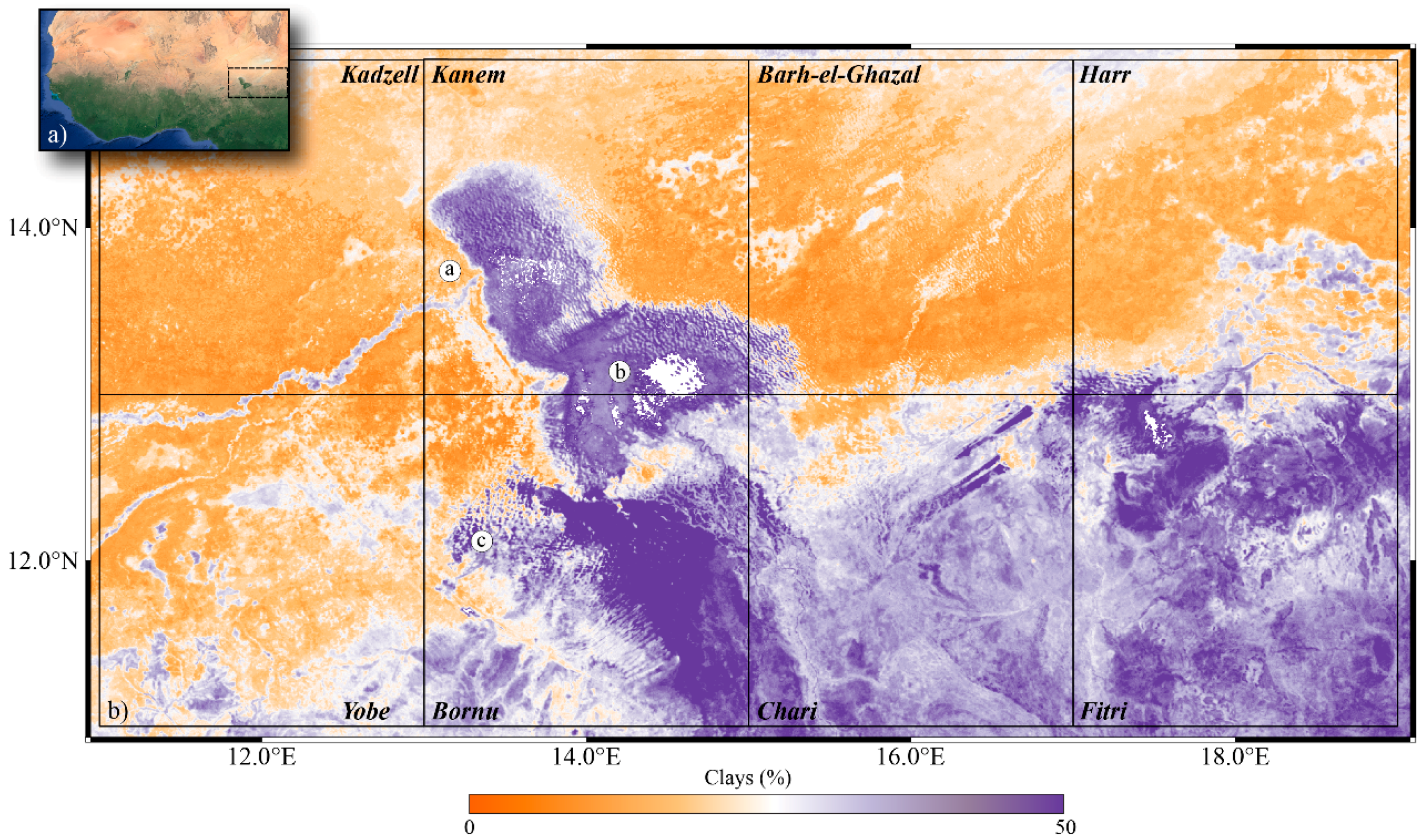

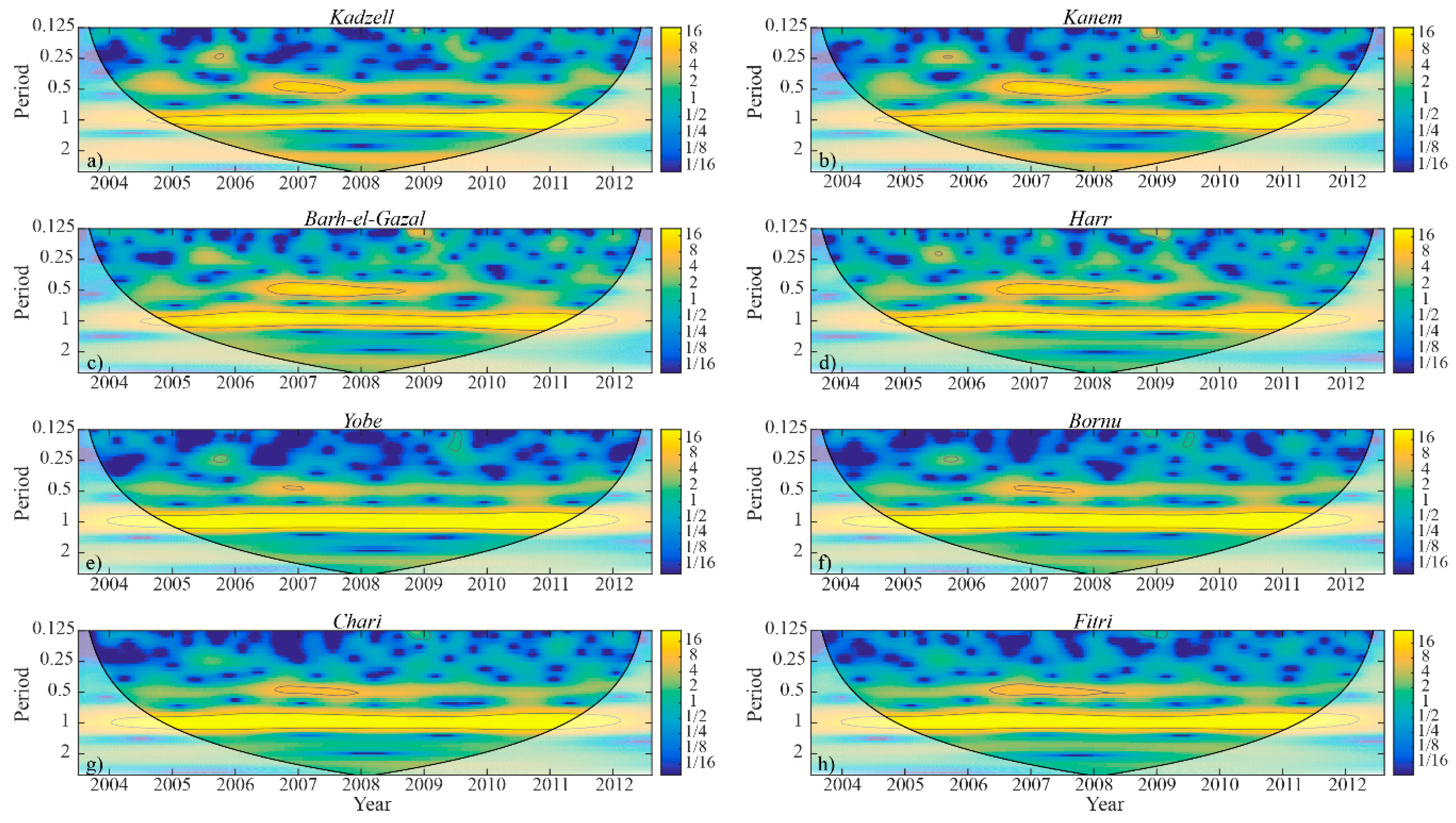
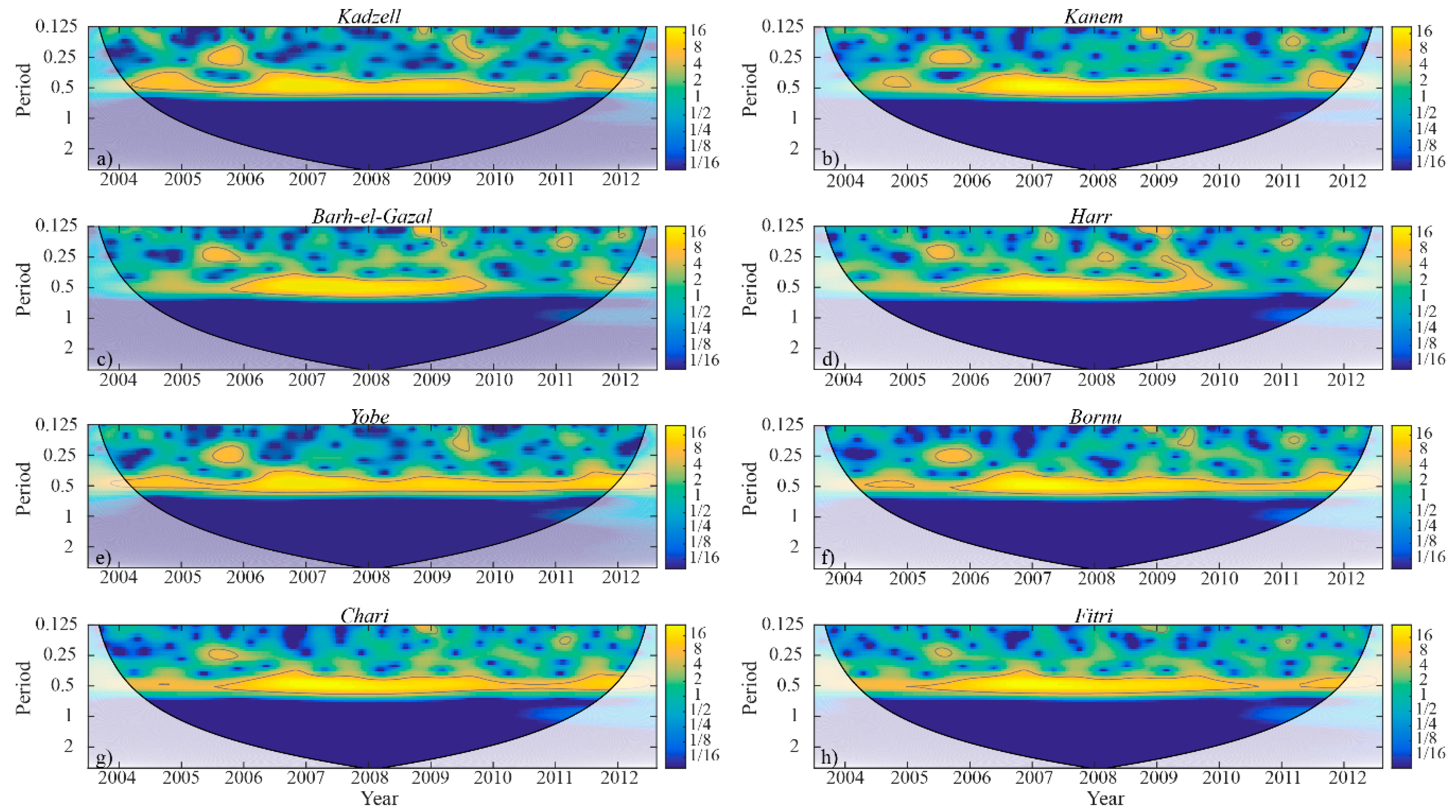
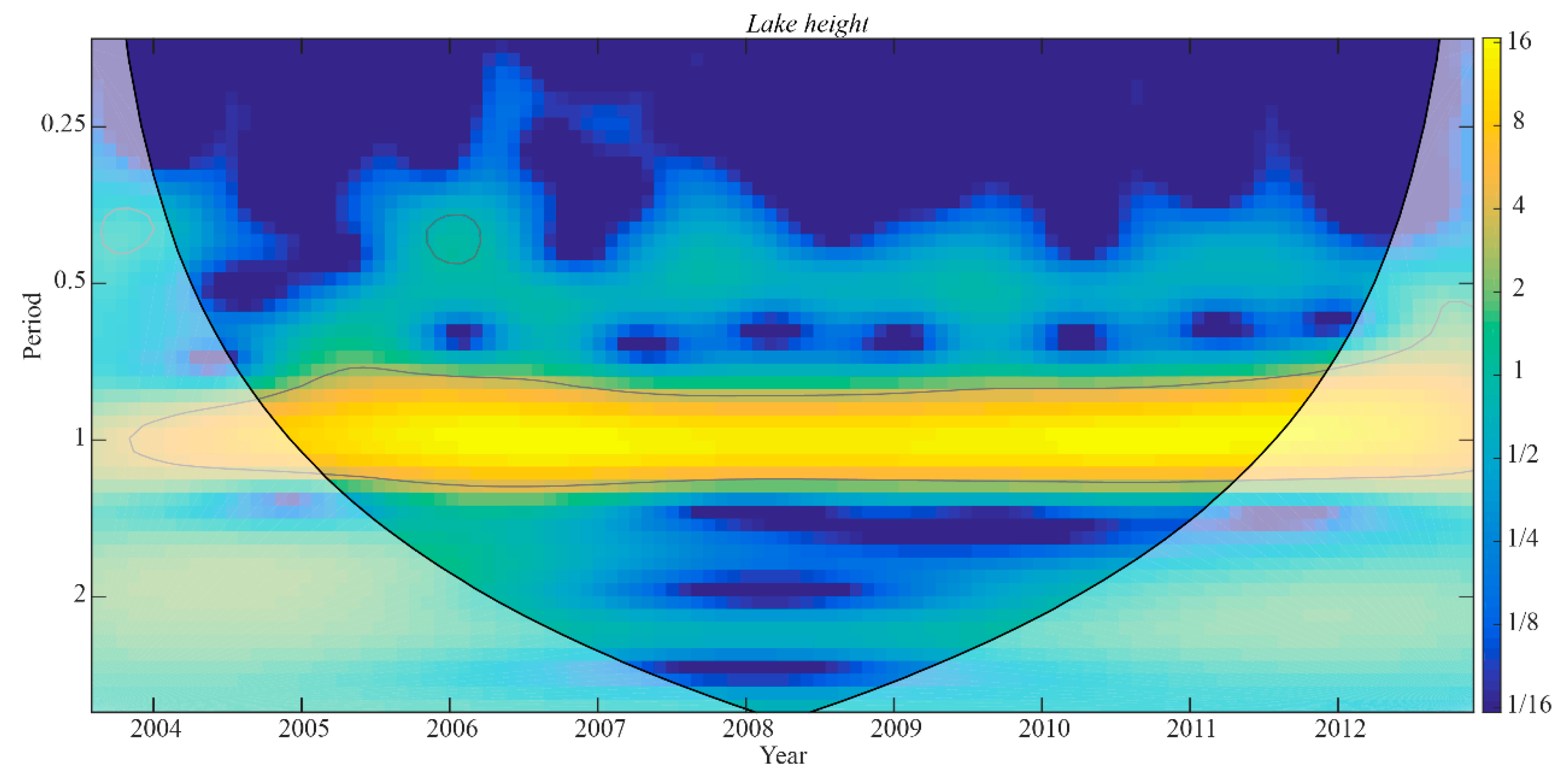
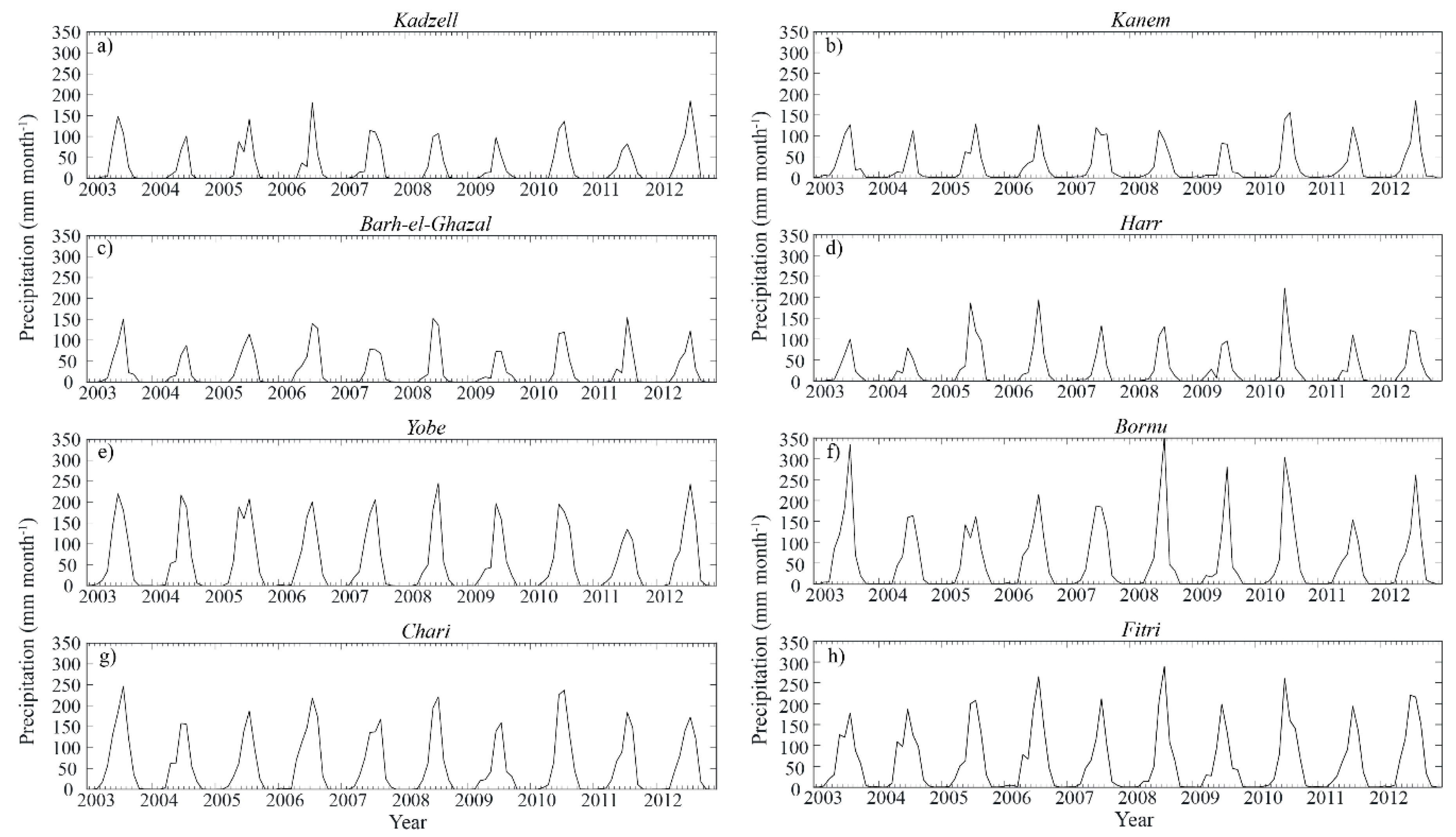
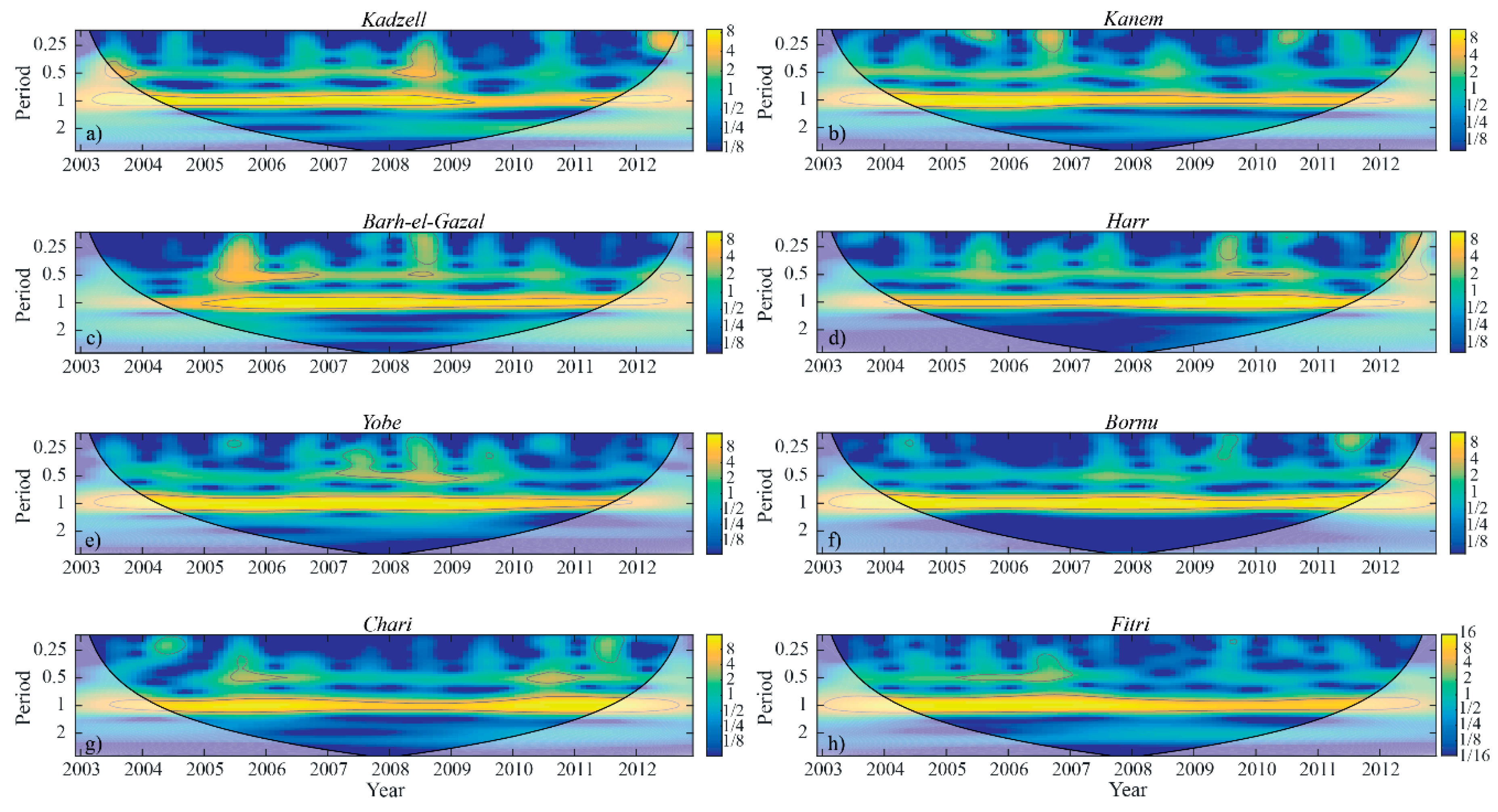

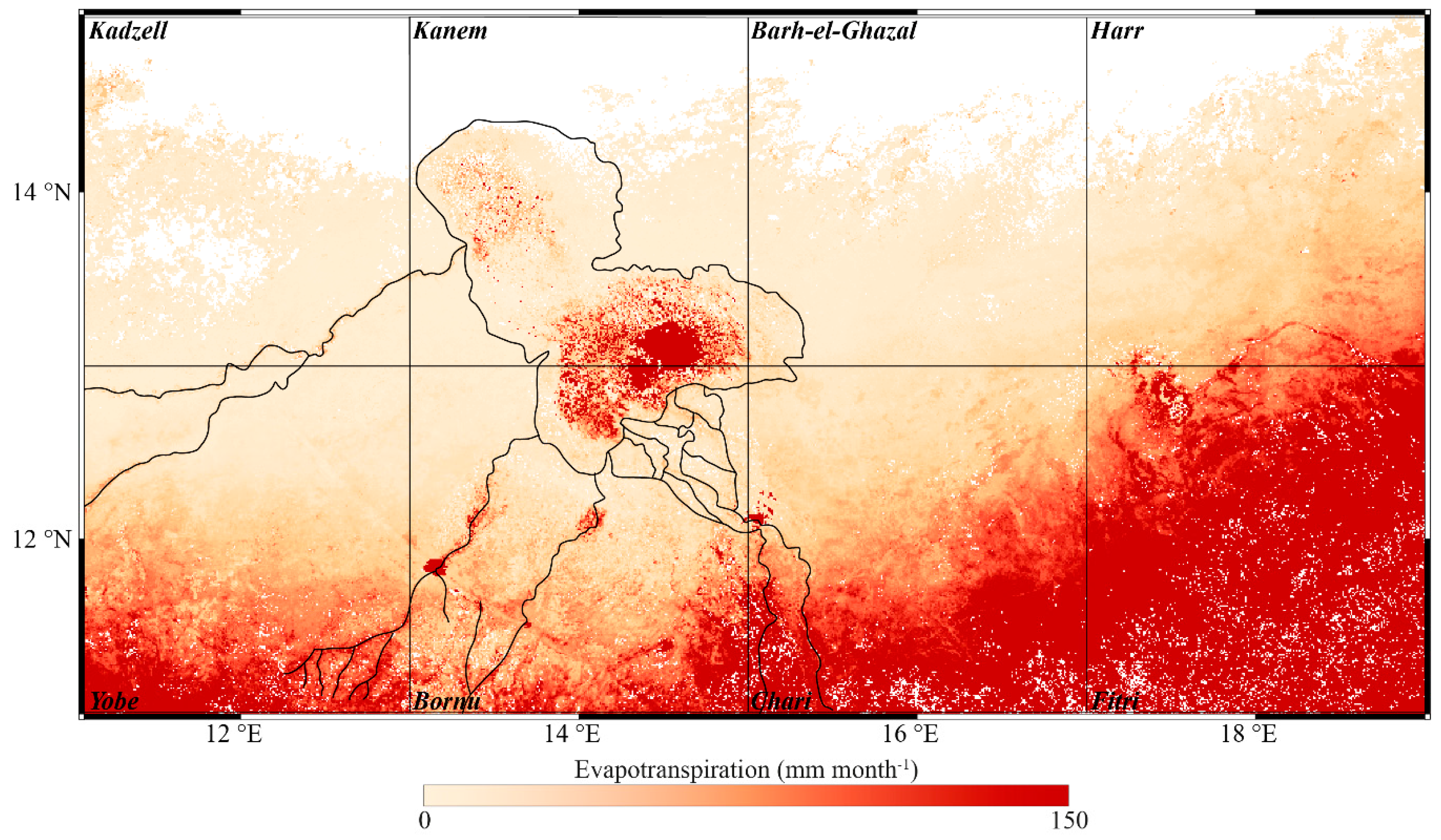
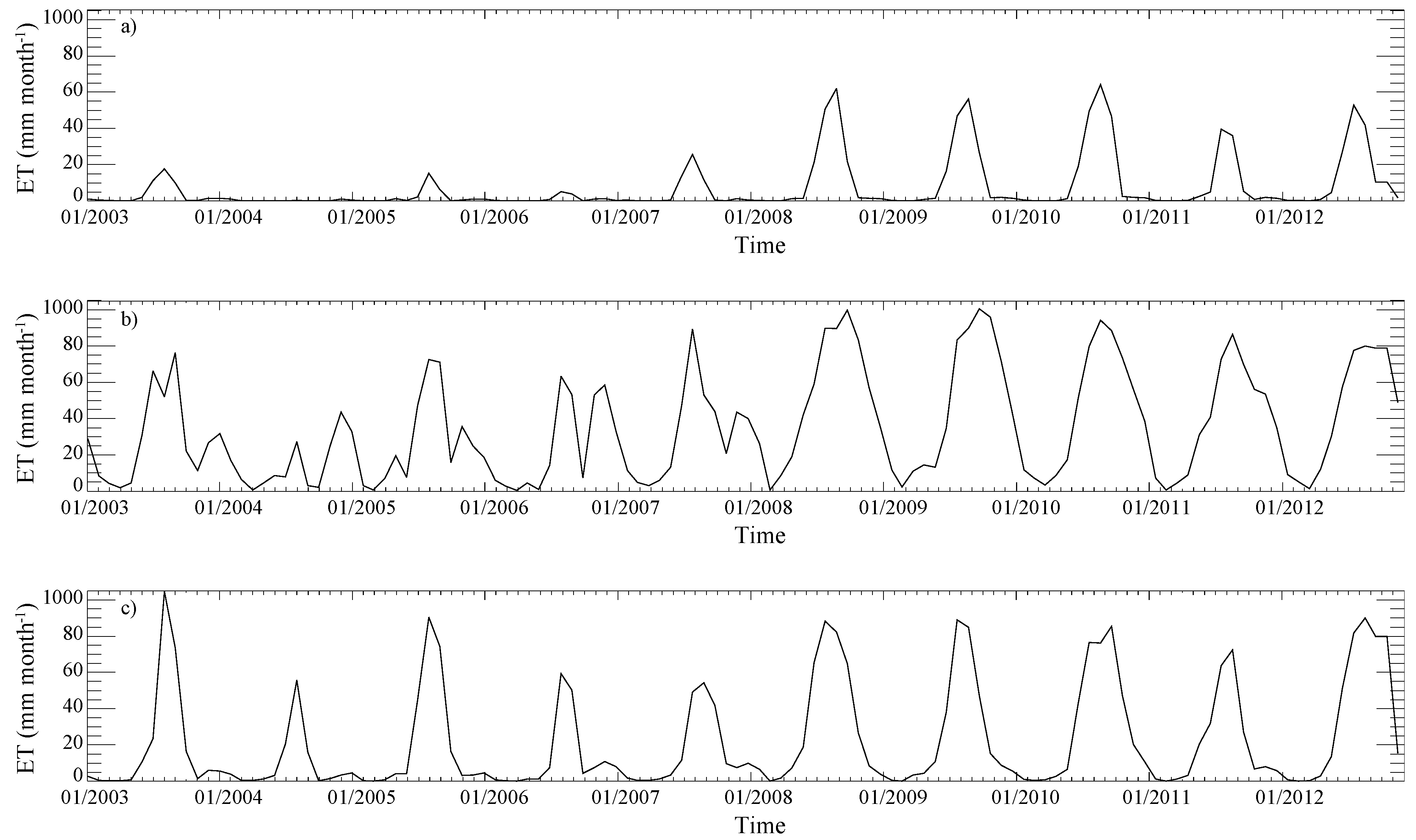
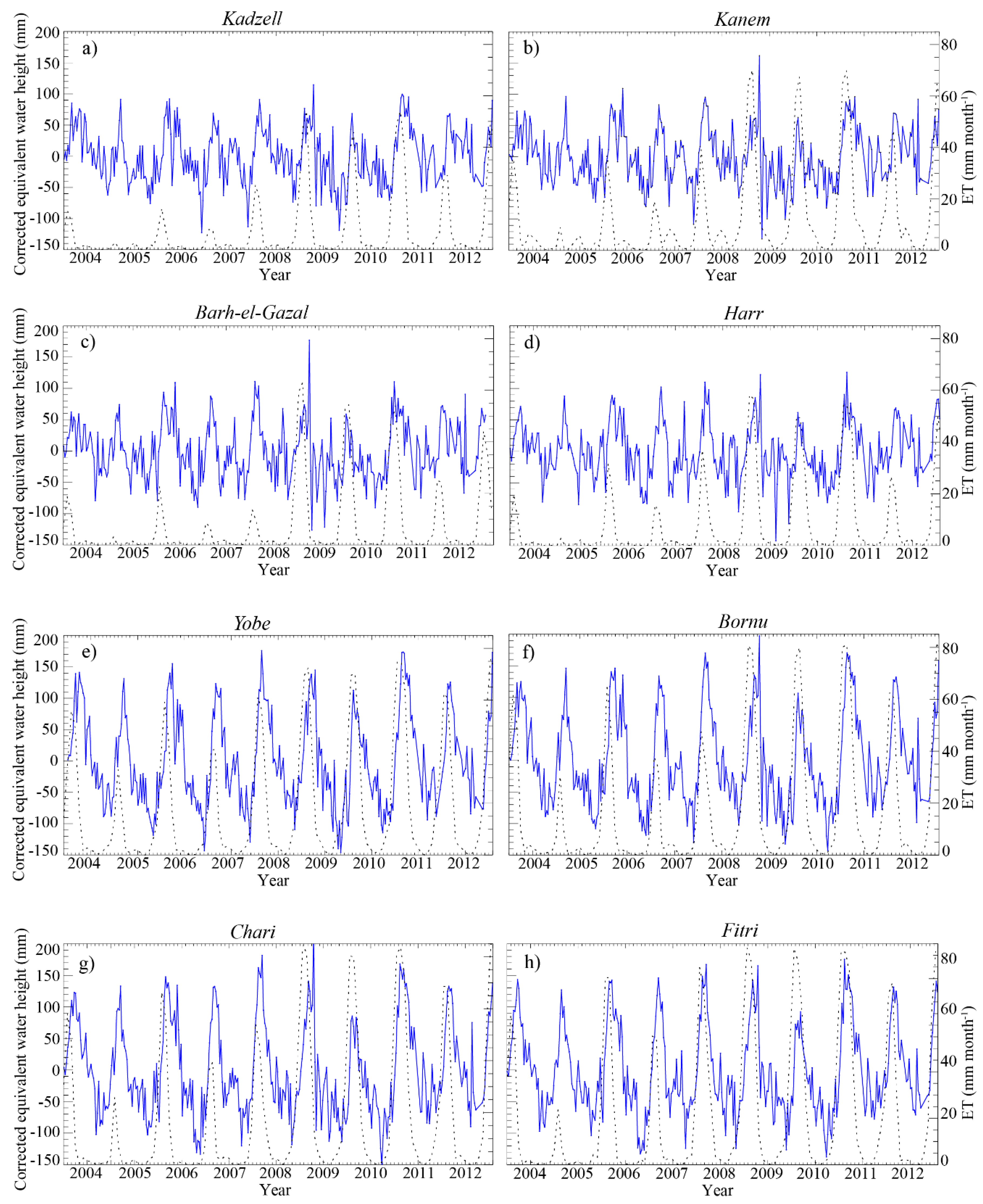

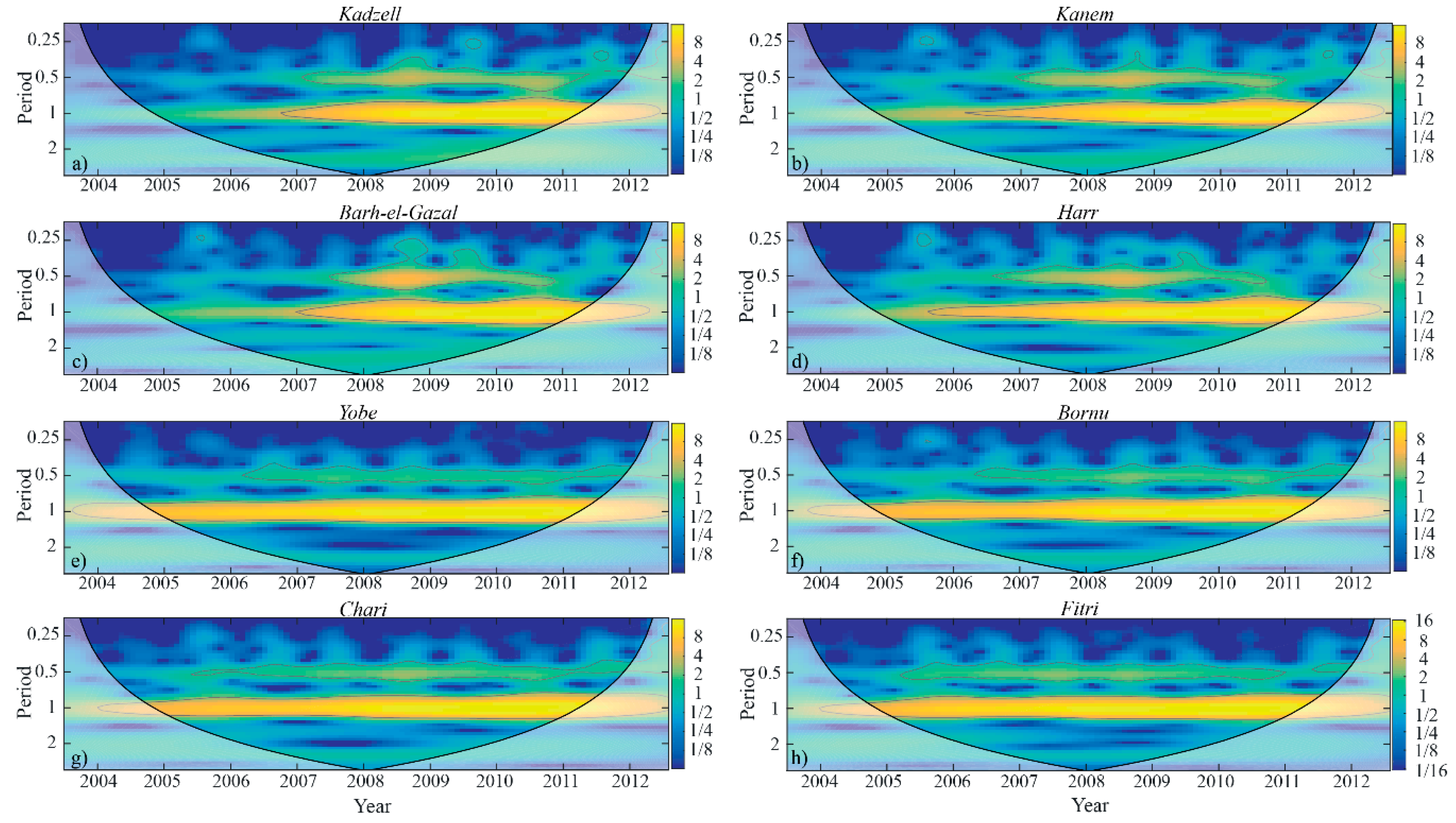
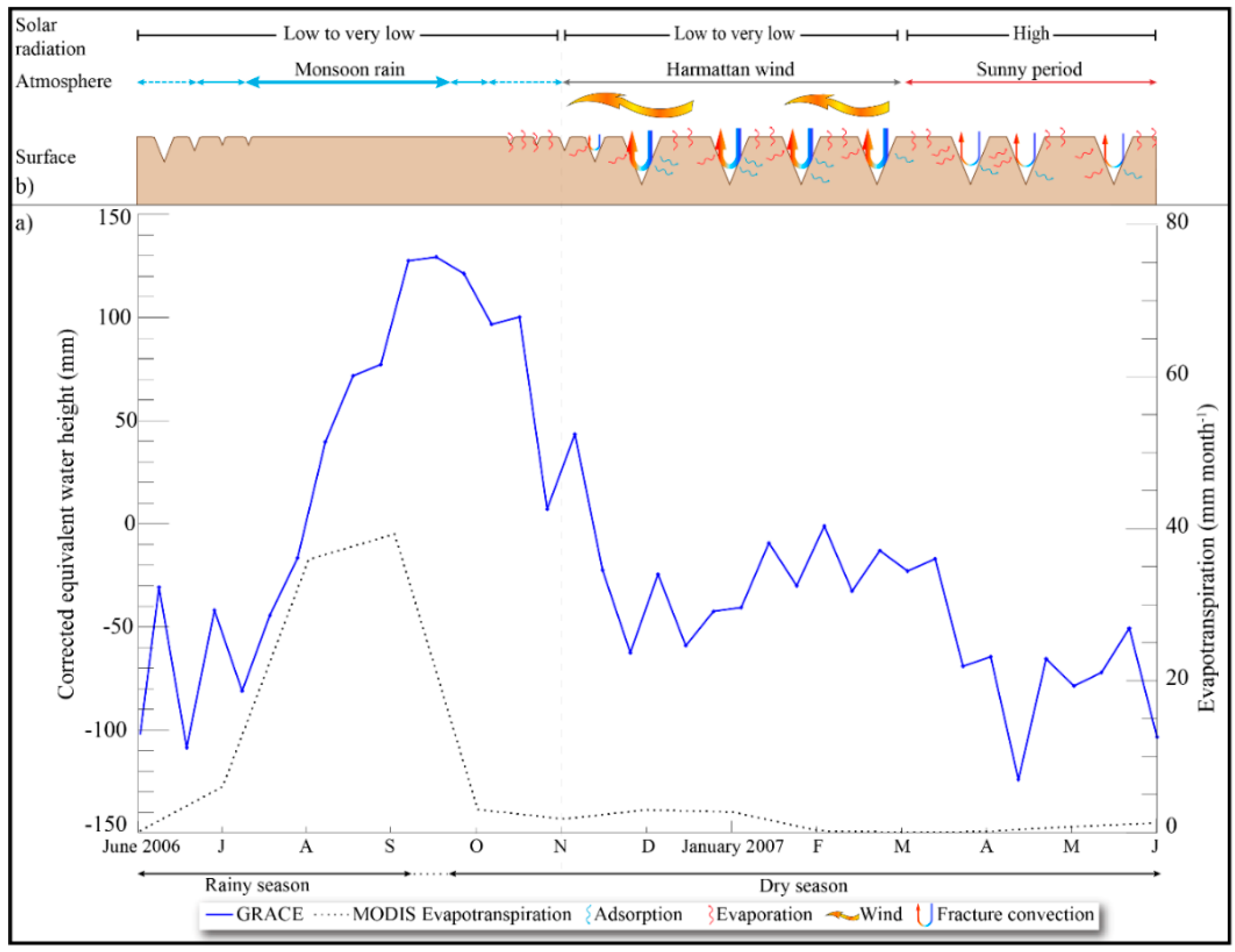
© 2018 by the authors. Licensee MDPI, Basel, Switzerland. This article is an open access article distributed under the terms and conditions of the Creative Commons Attribution (CC BY) license (http://creativecommons.org/licenses/by/4.0/).
Share and Cite
Lopez, T.; Ramillien, G.; Antoine, R.; Darrozes, J.; Cui, Y.-J.; Kerr, Y. Investigation of Short-Term Evolution of Soil Characteristics over the Lake Chad Basin Using GRACE Data. Remote Sens. 2018, 10, 924. https://doi.org/10.3390/rs10060924
Lopez T, Ramillien G, Antoine R, Darrozes J, Cui Y-J, Kerr Y. Investigation of Short-Term Evolution of Soil Characteristics over the Lake Chad Basin Using GRACE Data. Remote Sensing. 2018; 10(6):924. https://doi.org/10.3390/rs10060924
Chicago/Turabian StyleLopez, Teodolina, Guillaume Ramillien, Raphaël Antoine, José Darrozes, Yu-Jun Cui, and Yann Kerr. 2018. "Investigation of Short-Term Evolution of Soil Characteristics over the Lake Chad Basin Using GRACE Data" Remote Sensing 10, no. 6: 924. https://doi.org/10.3390/rs10060924
APA StyleLopez, T., Ramillien, G., Antoine, R., Darrozes, J., Cui, Y.-J., & Kerr, Y. (2018). Investigation of Short-Term Evolution of Soil Characteristics over the Lake Chad Basin Using GRACE Data. Remote Sensing, 10(6), 924. https://doi.org/10.3390/rs10060924







